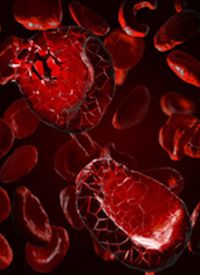Article
Ibrutinib Demonstrates Long-Term Efficacy in CLL in Real-World Setting
Author(s):
Ibrutinib induced a cumulative overall response rate of 90.0% in 3-year findings from the Belgian Ibrutinib Real‑World Data study of patients with previously untreated or relapsed/refractory chronic lymphocytic leukemia.

Ibrutinib (Imbruvica) induced a cumulative overall response rate (ORR) of 90.0% in 3-year findings from the Belgian Ibrutinib Real‑World Data (BiRD) study of patients with previously untreated or relapsed/refractory chronic lymphocytic leukemia (CLL).
At a median follow-up of 34.3 months (range, 0.2-69.9), the complete response rate was 16.7% and the partial response (PR) rate was 51.6%; the PR rate with lymphocytosis was 21.7%. The cumulative ORR was defined as the best ORRR at 60 months.
At the 12-month analysis, the cumulative ORR was 86.9%.
The efficacy population included 221 patients with CLL, which included patients analyzed prospectively (n = 71) and retrospectively (n = 150).
The median PFS for CLL was 38.3 months (Q1-Q3, 12.2–66.4) overall, not estimable (NE) (Q1-Q3, 15.7–NE) in the prospective group, and 51.5 (Q1-Q3, 29.1–NE) months in the retrospective group.
PFS was longer in patients without del17p and/or TP53 mutations (49.9 months; (Q1-Q3, 17.8-NE) than those with those abnormalities (41.5 months; (Q1-Q3, 21.3-NE).
The median overall survival (OS) was not estimable in either the prospective or retrospective subgroups. The 3-year OS rate overall was 62.9%, these rates were 60.6% in the prospective group and 76.3% in the retrospective group.
Investigators in the multicenter, observational BiRD study evaluated the real-world effectiveness and safety of ibrutinib in Belgian patients with CLL, mantle cell lymphoma and Waldenström’s macroglobulinemia. Only patients with CLL are included in this analysis.
This is the third of 4 planned interim analyses. The first occurred after enrollment of the final patient, the second after 18 months, and this analysis at 3 years with a data cutoff date of March 31, 2020. The fourth analysis is planned for early 2023.
The treating physician made treatment decisions according to routine clinical practice—participation in the observational study did not influence care. At initiation, 88.1% of patients were prescribed to daily 420 mg ibrutinib.
Investigators recruited adults with a confirmed diagnosis of CLL who were eligible for reimbursed ibrutinib treatment, according to Belgium’s National Institute for Health and Disability Insurance. Previously untreated patients without del17p and/or TP53 mutation who were fit to receive fludarabine-based regimens were not eligible for ibrutinib treatment. Patients were excluded if they were participating in another investigational or clinical study or in any expanded access program during treatment with ibrutinib.
The primary end points were investigator-assessed ORR and PFS. Secondary outcome measures included OS and safety, including treatment exposure and treatment-emergent adverse events (TEAEs).
The median age at ibrutinib initiation was 72 years (range, 38-90) years. Most (64.3%) patientswere male, 86.6% had an ECOG performance status of 0 to 1, and 17.8% had a history of significant cardiovascular (CV) disease. Fourteen of 38 (36.8%) patients had ongoing atrial fibrillation (AF) and other ongoing CV disease.
The median time from diagnosis to ibrutinib initiation was 5.8 years and 72.6% patients had at least 1 prior line of therapy. Seventy-eight (59.1%) of 132 assessed patients had del17p and/or TP53 mutation, and 72.5% of 80 patients assessed had unmutated IGHV. Investigators found that 43.6% of patients with del17p and/or TP53 mutations were treatment naïve, while 71.7% of patients without those mutations had at least 1 prior line of therapy.
Sixty (27.4%) patients were untreated, 53 (24.2%) received 1 prior line of therapy, 61 (27.9%) received 2, and 45 (20.5%) had received 3 or more prior lines of treatment. Overall, 6 (2.8%) patients underwent prior stem cell transplant—1 (1.4%) in the prospective group and 5 (3.4%) in the retrospective group.
The median time to best response was 4.4 months (range, 2.3-9.7). The median duration of response was 63.7 months (range, 31.5-NE). The median time to next treatment was 35.7 months (range, 11.7-NE).
Investigators assessed 226 patients for safety, 73 in the prospective group and 153 in the retrospective group. The median treatment duration was 25.5 months (range, 0.1–70.0) months. Duration was longer in the retrospective (28.6 months; range, 0.4–70.0), than in the prospective group (19.6 months; range, 0.1–45.1).
A total of 123 (54.4%) patients discontinued treatment during the analysis period, 38 in the prospective and 85 in the retrospective group. Twenty-nine (12.8%) discontinued for disease progression, 26 (11.5%) for toxicity, 21 (9.3%) for death, 18 (8.0%) for other reasons, 6 (2.7%) for comorbidities, 5 (2.2%) for physician’s preference, and 1 (0.4%) each for concomitant medication, patient preference, and surgery.
Investigator recorded no sudden cardiac deaths. The single cardiac-related death, a cardiac arrest, was determined not to be related to treatment. Two deaths, 1 case of pneumonia and 1 case of aspergillus infection, were very likely related to ibrutinib.
All patients experienced at least 1 TEAE. A total 58.9% of patients in the prospective group and 43.8% of those in the retrospective group had at least 1 serious TEAE.
Reference
Janssens A, Berneman ZN, Offner F, et al. Effectiveness and safety of ibrutinib for chronic lymphocytic leukemia in routine clinical practice: 3-year follow-up of the Belgian Ibrutinib Real-World Data (BiRD) study. Clin Hematol Int. Published online October 13, 2022. doi:10.1007/s44228-022-00020-8









